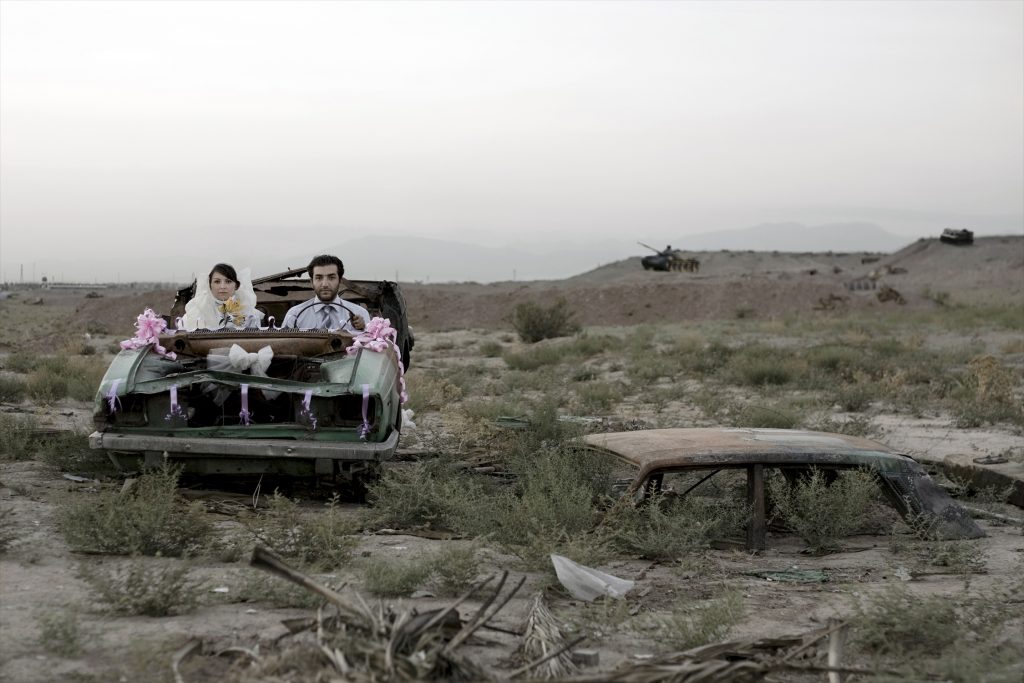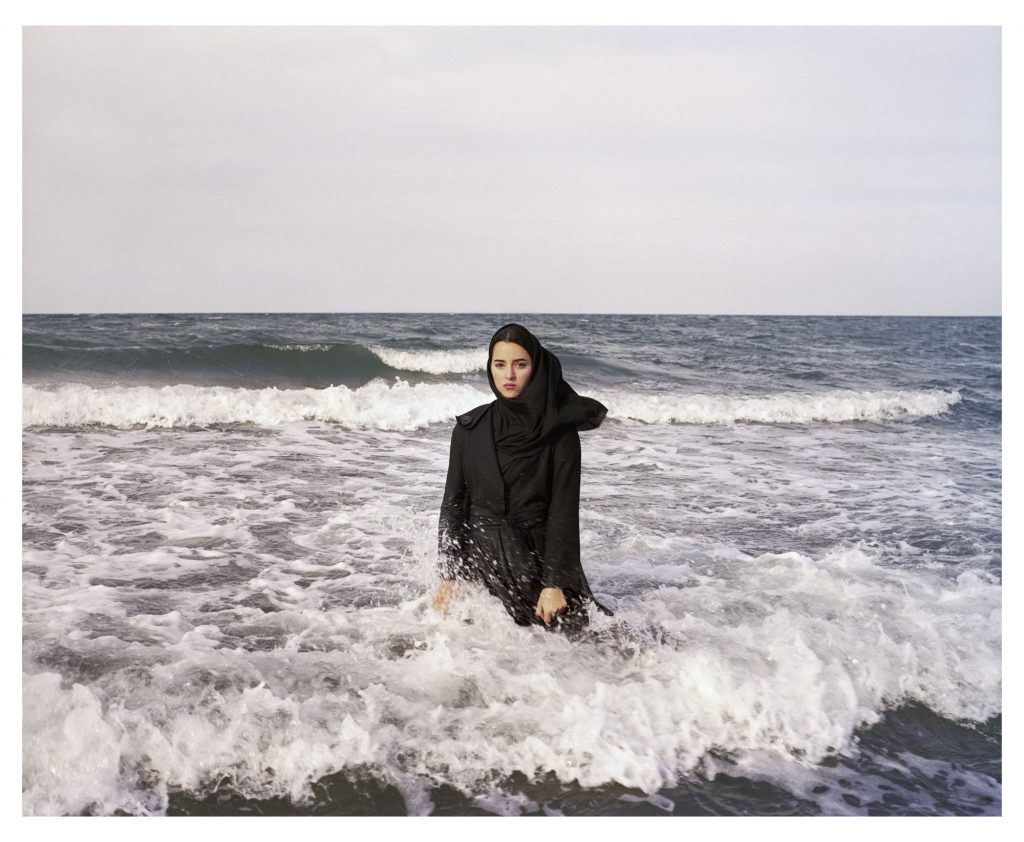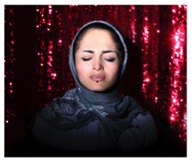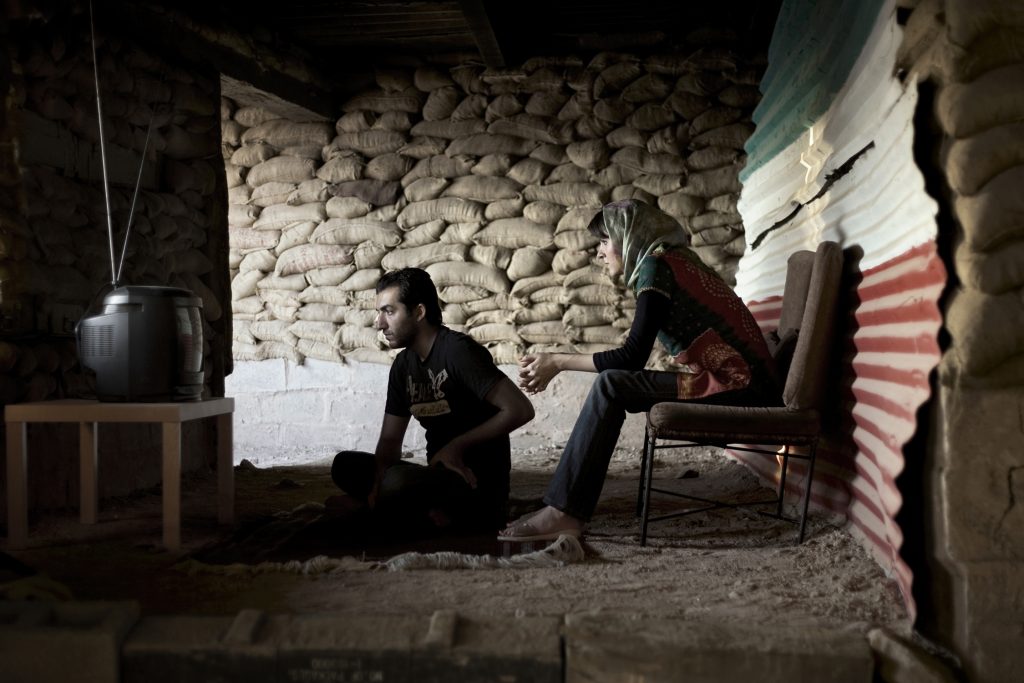An interview with curator Kristen Gresh
The Middle East has never been a simple region. Its complexity and diversity makes for a rich background upon which to paint contemporary issues, be they related to conflict or art, but mainstream media and most people tend to view the region as a monolith, mired in conflict, religious extremism and terrorism.
In light of this comes an exhibition scheduled to open April 8 at the National Museum of Women in the Arts in Washington D.C. She Who Tells a Story takes viewers on a journey into Iran and the Arab world through the perspective of 12 women photographers from throughout the region with extremely diverse backgrounds. Some are artistic photographers, and others are photojournalists, but each brings a unique perspective that defines what life in the Middle East means for them as contemporary women. They defy the conception of Arab and Iranian women being oppressed, and their images are a defiant statement of empowerment to the world.

Gohar Dashti, Untitled #5, from the series “Today’s Life and War,” 2008, Chromogenic print, 27 5/8 x 41 3/8 in.; Courtesy of the artist, Azita Bina, and Robert Klein Gallery, Boston; © Gohar Dashti
The Islamic Monthly caught up with Kristen Gresh, the Estrellita and Yousuf Karsh Curator of Photographs at the Museum of Fine Arts in Boston, who created this project and has worked closely with each of the featured artists.

Boushra Almutawakel, Untitled, from the series “The Hijab,” 2001; Chromogenic print, 47 1/4 x 39 3/8 in.; Courtesy of the artist and the Howard Greenberg Gallery
TIM: Tell us how you got involved with this project?
GRESH: I proposed this exhibition idea to the MFA shortly after I started working here, four years ago, and was excited to then have the opportunity to do it. About 10 years ago, I lived in Cairo, Egypt and followed the contemporary art scene, and got to know the photography world there, in particular. I also lived in Paris, France, before and after living in Egypt; a great deal of work from Iran and the Arab world is regularly shown in France as well. Proposing this show was an exciting opportunity to share new work with a new audience. I felt that some of the most compelling and powerful photographs in the region were being made by women, and that was why I chose for it to be a show of women photographers.
TIM: How long was this project in the making?
GRESH: Practically speaking, the logistics part of the exhibition was about a year in the making. However, I was following the contemporary photography scene in the Middle East for about 10 years previously.

Lalla Essaydi, Bullets Revisited #3, 2012; Triptych, chromogenic prints on aluminum, 150 x 66 in.; Courtesy of the artist, Miller Yezerski Gallery, Boston, and Edwynn Houk Gallery, NYC
TIM: How did you locate all the female photographers?
GRESH: I had been following the scene, so I had seen their work at galleries in the Middle East, and at galleries and exhibitions in France and around Europe. While researching the show, I reached out to the artists through their galleries or their websites.
TIM: How has the personal background of the artists influenced their work? For example, if they were educated, if they were poor, if they came from privileged backgrounds, what are you finding about the background of the women?
GRESH: I don’t feel comfortable commenting on this. It is not a consideration that I have when I’m looking at photographs. I judge the artwork for what it is and what it represents and how it relates to the rest of the contemporary art world. All photographs certainly reflect an artist’s own personal experience and background, but I can’t make a generalization about these artists’ backgrounds.

Newsha Tavakolian, Untitled, from the series “Listen,” 2010; Pigment print, 39 3/8 x 47 1/4 in.; Courtesy of the artist and East Wing Contemporary Gallery
TIM: Most of the motivation in wanting to know this is because, with women who come from particular parts of the world, it’s interesting to see what is it that allows for them to have that platform. Could they actually come from a particular background that allows for them to be a voice of either dissidence or voice of reason or inspiration? I think that’s where most of our intrigue comes from, sort of understanding the background of the women. … I think we were hoping to kind of get a little bit deeper into the women themselves and what you’ve learned about them in the process of curating. But it sounds as if there hasn’t been too much of that type of engagement.

Shirin Neshat, Divine Rebellion, from the series “The Book of Kings,” 2012; Acrylic on laser-exposed silver gelatin print, 62 x 49 in.; Courtesy of the artist and Gladstone Gallery, New York and Brussels; © Shirin Neshat
GRESH: I know a lot about the photographers, I’ve met with all of them and I’ve remained in touch with all of them. They have successful careers as photographers, some have been more involved in the photojournalism realm and others have been more involved in the creative photography realm. I understand your question and I understand the interest in it, but I don’t feel like it’s my place to make those kinds of judgments. If you have a specific question about a specific artist, I’m happy to answer.
For example, Newsha Tavakolian started as a photojournalist when she was a teenager. She had this great conviction and just showed up at the local newspaper. She started by answering the phone and she eventually became a contributing photographer. She was very much a self-taught photographer. Other photographers had training in college — it’s really a range. But I think it’s hard to make any general comments about the artists’ personal backgrounds. They all have very different voices — there are similarities between some and not between others. … I’m happy to talk about individual photographers and how they got to where they are, but it does not make any sense to talk in a general sense about the social or economic backgrounds of the artists.

Newsha Tavakolian, Maral Afsharian, from the series “Listen,” 2010; Pigment print, 23 5/8 x 31 1/2 in.; Courtesy of the artist and East Wing Contemporary Gallery
TIM: We know that the exhibition was displayed in the West Coast and obviously it’s coming to the East Coast. Do you anticipate that it may be received differently between the two places?
GRESH: I am not sure that I can comment about East versus West Coast reception, but I can say it has been at a range of museums from a university museum to encyclopedic museum. It is great to present it in different types of museums and hopefully reach the widest possible audience.
TIM: In this past year, so much attitude about Muslims, American Muslims, Islam, women in the Middle East, for example, has changed. In some ways it’s been a bit more hostile. Do you have any reflections on how the exhibition may be seen differently in light of the climate of America and how it ebbs and flows based on the politics in America toward Islam?

Shadi Ghadirian, Untitled, from the series “Qajar,” 1998, Gelatin silver print, 15 3/4 x 11 7/8 in.; Museum of Fine Arts, Boston; Museum purchase with the Horace W. Goldsmith Fund for Photography and Abbott Lawrence Fund, 2013.571; © Shadi Ghadirian; Photo © 2015 Museum of Fine Arts, Boston
GRESH: I hope that the exhibition can be a moment to put art and culture before politics. I hope that this exhibition will highlight the mosaic of different types of identities that there are within Iran and the Arab world.
TIM: This is what’s going to resonate with the readers and move them to want to come and see the exhibition. What do you think that the women from Iran and the Middle East are collectively saying to the audiences and through this exhibition?
GRESH: They are not collectively saying anything, but the artists are sharing a variety of contemporary stories and contemporary narratives that are diverse within themselves. It ranges from the very personal to the political. The work addresses regional identity, female identity, youth identity and even political identity. These contemporary stories are far removed from tales of Scheherazade — here we have contemporary narratives made by working photographers.

Shadi Ghadirian, Nil, Nil #11, 2008, Pigment print photograph, 29 7/8 x 29 7/8 in.; Museum of Fine Arts, Boston; Museum purchase with funds donated by Pat and Arthur Stavaridis, 2014.20; © Shadi Ghadirian; Photo © 2015 Museum of Fine Arts, Boston
TIM: Do you have any photos that struck you or really moved you, they were either really emotional, really powerful, any particular images that you want to point out that resonated with you in particular and why?
GRESH: I find all of the works in the show to be powerful. One example is the series called Nil, Nil by Shadi Ghadirian. Each photograph is a juxtaposition of a feminine and a masculine object, showing some type of paradox. The intention of the series is to bring the stories of women during war to the forefront. Red high heels are next to drooping military boots — it is almost as if the women’s heels and the man’s army boots are in a disembodied dance. The whole series is about how war is ever-present, as we see in the image that shows a hand grenade in a bed.
The series by Gohar Dashti, called Today’s Life and War, also tells a powerful story. A couple is either performing acts of daily life or participating in celebratory moments in a fictionalized battlefield, frequently surrounded by military tanks. There is a kind of irony and humor there, but it’s really about perseverance and, again, the ever present aspect of war. Dashti grew up during the Iran-Iraq War and the series is very much about determination and survival, which is particularly powerful.

Tanya Habjouqa, Untitled, from the series “Women of Gaza,” 2009; Pigment print, 20 x 30 in.; Museum of Fine Arts, Boston; Museum purchase with general funds and the Horace W. Goldsmith Fund for Photography, 2013.567; Photo © 2015 Museum of Fine Arts, Boston
TIM: One of the types of things that we do at the magazine obviously is to humanize people, to show people for who they are, and allow for the stories to come out. One of the things that I know would probably come up by some of our readers is to ask if you know that the artistic expressions of the photographs, if there is any sort of risk that they may have faced by allowing the works to be displayed? Some of the places, this type of artistic expression is heavily censored and discouraged. So did you have any experiences with this or any sort of moments where the authors would let you know this or anything you might have experienced in trying to display some of the work?
GRESH: No, I didn’t. I can tell you though that Newsha Tavakolian, Gohar Dashti and Shadi Ghadirian are all from Iran and they all find it very important that their work, when it’s shown for the first time, is shown in their country. They are strong believers of the fact that Iran is an important audience for them, as is the rest of the world. They show at their local Tehran galleries and they show internationally. But they all feel it’s very important to show their work at home first and then abroad.

Gohar Dashti, Untitled #1, from the series “Today’s Life and War,” 2008, Chromogenic print, 27 5/8 x 41 3/8 in.; Courtesy of the artist, Azita Bina, and Robert Klein Gallery, Boston; © Gohar Dashti
TIM: As you’re talking, I wanted to ask the question, what makes all the women same and where do they differ? But then, I had to catch myself because I think oftentimes, we create a monolith, Arab women, and we group them together as Arab women. In what ways would you state that one of the things that you’re doing through this exhibition is showing this complex diversity of Arab and Middle Eastern women again in front of and behind the lens, so that you see the similarity in the sense of they’re all human, and they all have human emotions and feelings, but at the same time, they’re all vastly different. How would you respond to that?

Nermine Hammam, The Break, from the series “Cairo Year One: Upekkha,” 2011; Chromogenic print, 23 5/8 x 23 5/8 in.; Courtesy of Taymour Grahne
GRESH: That is certainly one of the goals of this exhibition, to really invite people to think differently and understand this mosaic of identities and to shift our ideas. One of the texts in the catalog is called Stories We Thought We Knew, which evokes the fact that we all have various preconceived notions. The title of the exhibition is very precise in terms of women photographers from Iran and the Arab world, and it is important to note that some of the women aren’t Arab, and not all of them are Muslim. There is great diversity within Iran and the Arab world, so I hope that people looking at these 12 distinct bodies of work can see that there is great diversity. I intentionally included both photojournalism and fine art photography to show that there are people working in many different ways, as there are here and everywhere. I specifically chose work that was related to the roots and the cultural heritage of the photographers, and all of the work is about the region, with the intention of expressing the rich diversity within the region.
TIM: Were there photos that you chose not to include either for political reasons or if you felt that they were divisive? How did you make decisions on pieces you couldn’t include and why?
GRESH: For me, I definitely did not censor myself in my choices in any way. I chose the strongest, compelling, most powerful, provocative work. I chose it based on how the photographs worked together in different groups, and I really chose it based on the strongest work. I met with many other photographers and looked at a lot of other work, and in the end, it was about choosing the strongest work. I definitely didn’t shy away from choosing things that I thought would make sense for the exhibition.
TIM: Any last-minute thoughts on why you want to encourage people to come and see the exhibition?
GRESH: I think it’s an important moment in time, especially right now in Washington, D.C., specifically, to really put art and culture before politics, and before the images and ideas that the media is feeding to all of us.









